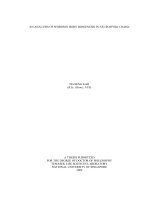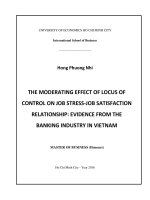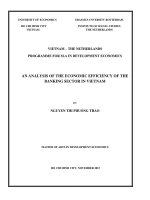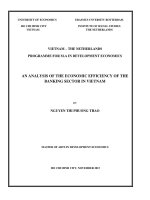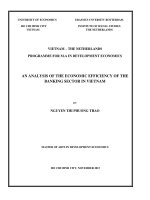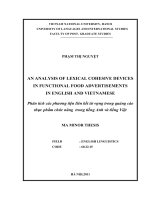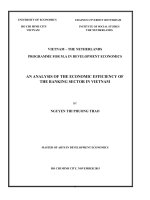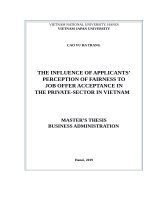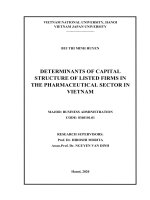An analysis of the economic efficiency of the banking sector in vietnam
Bạn đang xem bản rút gọn của tài liệu. Xem và tải ngay bản đầy đủ của tài liệu tại đây (1.53 MB, 73 trang )
UNIVERSITY OF ECONOMICS
ERASMUS UNVERSITY ROTTERDAM
HO CHI MINH CITY
VIETNAM
INSTITUTE OF SOCIAL STUDIES
THE NETHERLANDS
VIETNAM – THE NETHERLANDS
PROGRAMME FOR M.A IN DEVELOPMENT ECONOMICS
AN ANALYSIS OF THE ECONOMIC EFFICIENCY OF THE
BANKING SECTOR IN VIETNAM
BY
NGUYEN THI PHUONG THAO
MASTER OF ARTS IN DEVELOPMENT ECONOMICS
HO CHI MINH CITY, NOVEMBER 2015
i
ABSTRACT
This study measures economic efficiency of commercial banks in Viet Nam and its
determinants. The Stochastic Frontier Model is applied for a profit function. We include internal
factors (including price of fund, price of physical capital, price of labor, price of loan and price
of other earning assets) and macroeconomic factors (economic growth, inflation rate, and other
macroeconomic environment variables) in the profit function. The empirical results show that the
efficiency of Vietnamese commercial banks seems to be fluctuated steeply over the period 20082013. In terms of the efficiency of different groups of commercial banks, the profit efficiency of
the State-owned commercial banks and Private commercial banks follow different trend.
Particularly, the state owned commercial bank’s group seems to have extremely higher profit
efficiency score then private commercial bank.
ii
LIST OF ABBREVIATION
LSDV
Least squares with dummy variables
GLS
Generalized least squares
SFA
Stochastic Frontier Analysis
SFM
Stochastic Frontier Model
DEA
Development Envelopment Analysis
PE
Profit efficiency
CRER
Credit risk
LIQD
Liquidity
CON
Concentration
DEV
Banking development
INF
Inflation rate
GDP
GDP
SIZE
SIZ
PROFIT
Total profit
PBT
Profit before tax
X1
Labor
X2
Capital
X3
Fund
W1
Price of labor
W2
Price of capital
W3
Price of fund
Y1
Loan
Y2
Other earning asset
P1
Price of loan
P2
Price of other earning asset
TE
Technical efficiency
EE
Economic efficiency
AE
Allocative efficiency
Obs
Number of observations
SOBs
State-owned commercial banks
PCBs
Private commercial banks
iii
LIST OF TABLES
Table 3.1: Variables of potential correlates of profit efficiency function.................................. 32
Table 3.2: Data sample of observations over period 2008-2013 ............................................... 43
Table 4.1: Overview of variable in profit function .................................................................... 35
Table 4.2: A summary statistics of profit before tax, inputs, outputs and prices used in the
profit efficiency estimation for the whole period 2008-2013 .................................................... 38
Table 4.3: A summary statistics of inputs, outputs and prices used in the profit efficiency
estimations: (million VND units for X1, X2, X3, Y1, Y2) ....................................................... 39
Table 4.4: A summary statistics of potential correlated of profit efficiency ............................. 40
Table 4.5: Potential correlates of profit before tax (PBT) with time-invariant fixed-effects
model.......................................................................................................................................... 41
Table 4.6: Banking profit efficiency scores in the period 2008-2013 with time-invariant fixedeffects model .............................................................................................................................. 42
Table 4.7: Potential correlates profit efficiency through time-invariant fixed-effect model ..... 43
Table 4.8: Potential correlates of profit before tax (PBT) with Cornwell et al (1990) time
varying fixed-effects model ....................................................................................................... 44
Table 4.9: Banking profit efficiency scores in the period 2008-2013 with time-varying Battese
and Coelli (1995) model .......................................................................................................... 45
Table 4.10: Potential correlates profit efficiency with Kumbhakar (1990) time-varying
parametric model (half-normal) ................................................................................................. 46
Table 4.11: Average banking profit efficiency score of 27 commercial bank in Vietnam and its
ranking from 2008 to 2013 ........................................................................................................ 48
iv
LIST OF FIGURES
Figure 1.1: Input-oriented efficiency ...........................................................................................13
Figure 1.2: Output-oriented efficiency ........................................................................................14
Figure 4.1: Graph of scatter between Profit before tax (Pbt) and total number of staff (X1) from
2008 to 2013 ................................................................................................................................36
Figure 4.2: Graph of scatter between Profit before tax (Pbt) and total fixed - asset (X2) from
2008 to 2013 ................................................................................................................................36
Figure 4.3: Graph of scatter between Profit before tax (Pbt) and total deposit from customer
(X3) from 2008 to 2013 ...............................................................................................................36
Figure 4.4: Graph of scatter between Profit before tax (Pbt) and total loan from customers (Y1)
from 2008 to 2013 ........................................................................................................................36
Figure 4.5: Graph of scatter between Profit before tax (Pbt) and total asset (Y2) from 2008 to
2013..............................................................................................................................................36
Figure 4.6: Graph of scatter between Profit before tax (Pbt) and Price of labor (W1) from 2008
to 2013 .........................................................................................................................................36
Figure 4.7: Graph of scatter between Profit before tax (Pbt) and Price of capital (W2) from 2008
to 2013 .........................................................................................................................................37
Figure 4.8: Graph of scatter between Profit before tax (Pbt) and Price of fund (W3) from 2008
to 2013 .........................................................................................................................................37
Figure 4.9: Graph of scatter between Profit before tax (Pbt) and Price of loan (P1) from 2008 to
2013..............................................................................................................................................37
Figure 4.10: Graph of scatter between Profit before tax (Pbt) and Price of other earning asset
(P2) from 2008 to 2013 ................................................................................................................37
Figure 4.11: Profit efficiency score from 2009 to 2013 with time-invariant fixed-effects model
......................................................................................................................................................43
Figure 4.12: Profit efficiency score of SOBs, PCBs and all banks from 2009 to 2013 with timevarying Battese and Coelli (1995) model ....................................................................................46
v
LIST OF APPENDIXES:
Appendix 1: List of Vietnamese commercial banks in Vietnam. Data was collected from
www.taichinhvietnam.com and sorted based on their charter capital .........................................57
Appendix 2: The result of estimation about the determinants of banking profit before tax and its
potential correlate through different type of model .....................................................................59
Appendix 3: Descriptive statistics of profit efficiency estimation through different type of model
......................................................................................................................................................67
vi
TABLE OF CONTENTS
ABSTRACT .................................................................................................................................... ii
LIST OF ABBREVIATION .......................................................................................................... iii
LIST OF TABLES ......................................................................................................................... iv
LIST OF FIGURES ........................................................................................................................ v
LIST OF APPENDIXES: .............................................................................................................. vi
CHAPTER I: INTRODUCTION .................................................................................................... 0
1.
Introduction: ......................................................................................................................... 0
2.
Research objective ............................................................................................................... 1
CHAPTER II: LITERATURE REVIEW ....................................................................................... 2
1.
Theory of the efficiency ....................................................................................................... 2
2.
Reviews of empirical study on bank efficiency ................................................................... 5
2.1 Overview on bank efficiency ............................................................................................ 5
2.2 Determinants of banking efficiency ................................................................................ 7
2.3
Bank efficiency measurement ....................................................................................... 9
CHAPTER III: DATA AND METHODOLOGY ........................................................................ 21
1.
Overview of the banking industry in Vietnam ................................................................... 21
2.
Analytical framework ........................................................................................................ 23
3.
Research method ................................................................................................................ 23
4.
Theoretical Model .............................................................................................................. 23
5.
Estimation Methodology.................................................................................................... 24
6.
Model specification ............................................................................................................ 25
7.
Functional form .................................................................................................................. 26
8.
Profit Efficiency ................................................................................................................. 26
9.
Variables description ......................................................................................................... 28
10. Data sources: ...................................................................................................................... 33
CHAPTER IV: RESULTS AND DISCUSSION ......................................................................... 35
1.
Descriptive statistics .......................................................................................................... 35
2.
Regression results .............................................................................................................. 38
2.1 Time-invariant fixed-effects model ................................................................................. 38
vii
2.2 Time-varying fixed-effects model ................................................................................. 42
CHAPTER V: CONCLUSION..................................................................................................... 47
REFERENCES ............................................................................................................................. 49
APPENDIX ................................................................................................................................... 54
viii
Vietnam – Netherlands Programme for M.A in Development Economics
CHAPTER I: INTRODUCTION
1. Introduction:
In most countries, the banking sector is considered as a key indicator to ensure the
national economy operates smoothly. Banking industry is widely considered as the backbone
of an economy and highly regulated in many countries. Banks usually has been considered as
key players in providing capital and stimulating economic development. In the study of
Demirguc & Huizinga (2000), it showed that when an economy is developed at a certain
level, it requires an intensive support from the stable and sustainable national financial
system.
Prior studies in the body of literature indicate that there are a wide range of factors
affecting the bank efficiency which can be classified into two main groups namely external
factors (e.g. macroeconomic factors and industrial factors) and internal factors of commercial
banks (e.g. size, losses, liquidity, and other factors). Particularly, Hasan and Marton (2003)
examines the relationship between the development and efficiency of banking sector while
Hou, Wang, and Zhang (2014) measure the linkages among market structure, risk taking and
efficiency of commercial banks. Due to their importance on the financial sector and their
influence on the national economy, this sector requires a high regulation by the government.
However, in most developing countries like Vietnam, there is lacks of perfect regulation to
support this sector to stabilize and develop. Like other countries, the banking system in
Vietnam provides many products from retail banking such as saving accounts, deposits,
credit/debit card, mortgage, loans to commercial banking such as business loan, capital
equity, risk management, and credit services.
As commercial banks have evolved in Vietnam before the investment banks, this
service is one of the most sensitive business which suffers direct and indirect impacts on
several intrinsic obstacles of the economy as well as the external effects, thus stabilizing the
currency and the banking system play an important factor, primarily in the financial system
stabilization. Therefore, understanding the efficiency of the banking system as well those
factors affecting the banking operations attracts a lot of attention from many economists and
scholars all over the world. In measuring efficiency, people usually choose between technical
efficiency and economic efficiency. We choose economic efficiency as this is more
comprehensive. In this thesis, the profit function is used to measure economic efficiency.
0
Vietnam – Netherlands Programme for M.A in Development Economics
2.
Research objective
While the capital funds raised for the national economy from those commercial banks
are enormous, limited research was carried out about how these banks operate and whether
they operate efficiently. With a proper measurement about banking efficiency together with a
wealth of predictive determinants will help the public to indicate how well a certain
commercial bank operate in the competitive market like Vietnam. Secondly, by improving
the performance of individual banks, the whole national banking system will function much
more efficiently and effectively. However, at the moment, most of studies focused on
qualifying the efficiency of the commercial banks (Nguyen, Roca, & Sharma, 2004) or
determining certain large-scale economic factors affecting commercial banks (Athanasoglou,
Brissimis, & Delis, 2008) without quantifying these factors to rank these commercial banks
in the global scale. Hence, the aim of this thesis is to verify the connection between the
current financial growth at the national scale and the efficiency performance of commercial
banks in Vietnam.
In details, this thesis is to understand the connection between the economic efficiency
and the economic growth of the banking system based on two following smaller objectives:
How efficient are commercial banks in Vietnam?
Which factors affect the economic efficiency of commercial banks?
This is the research of Vietnamese banks efficiency that will convey the managers to
identify the banks’ weakness as well as the causes of those weaknesses so that they can come
up with the right strategies, which will bring the best result given the same level of resource
inputted. In addition, this will be a useful research to analyze inefficiencies and minimize it in
order to improve the performance of Vietnamese banking industry. Moreover, this research
also demonstrates the reality of Vietnamese banking industry, which will be a useful guide
for foreign investors to start financing their equity in this dynamic industry.
1
Vietnam – Netherlands Programme for M.A in Development Economics
CHAPTER II: LITERATURE REVIEW
The concept “efficiency” in general and “bank efficiency” in particular are common
terms in the body of literature of economic discipline. These could be used to refer to the
competitive capability of entities in the economy. The chapter covers a broad review on
foundational theories on efficiency, bank efficiency and characteristics of the terms. The
measurement approaches as well as factors affecting bank efficiency.
1. Theory of the efficiency
In the production economics, the definitions of efficiency and productivity are two
concepts proxy for two different things. Firstly, the definition of “productivity” and
“efficiency” in terms of firm production has to be differentiated. Clearly speaking,
“productivity” considers the entire elements that decide the level of output achieved with the
amount of input given. Efficiency, however, have a different meaning compared to
productivity.
Efficiency includes three types (technical efficiency, allocative efficiency and
economic efficiency). The function of economic efficiency consists of profit efficiency and
cost efficiency. In this study, profit efficiency function is used to measure economic
efficiency.
It relates to the production frontier. This frontier presents the level of output that can
be reached a peak with the same level of input amount. The firm, which produces on this
frontier, will be considered efficiency. Also, going beyond this frontier is unrealistic because
there is a limitation of its performing ability. Similarly, it is inefficient producing below this
frontier. The further distance, the more inefficiency the firm is.
Even though productivity and efficiency are two separate concepts, they are closely
related. Therefore, if the firm expects to improve its productivities, they will have to produce
more efficiently. Other elements that makes the level of productivity are changed in the
quantities and proportion of inputs (changing its scale efficiency), an innovation of
technology (change in technology level), or according (Coelli et al., 2005) we make
combinations between all above factors.
The definition of efficiency is about the transforming performance between the
numbers of inputs into outputs (Forsund & Hjalmarrson, 1979). Hence, the efficiency is
2
Vietnam – Netherlands Programme for M.A in Development Economics
usually considered as an essential competitive force of entities in an economy such as a
branch, industry, or an entire system. However, as the society gets more advanced, the
definition of efficiency changes to be more specific. For example, Saha & Ravisankar (2000)
focused on the basic stage to measure the value of output at a given amount of input from the
engineering perspective. In order to attain an efficient point, Koopmans (1951) proposed the
necessary of balancing the equivalent unit of different outputs. In other word, the most
efficiency is the point at which one output is used to maximize a given amount of the input.
Given that, Debreu (1951) and Sephard (1953) developed a quantitative measurement of
efficiency for the outputs and inputs respectively. Debreu (1951) measured the distance
between the produced output and the predicted output that could have been produced from a
given amount of inputs while Sephard (1953) measured the difference the actual input and the
minimum possible amount of inputs.
Later, Farrel (1957) brought the measurement of efficiency into the next level by
establishing the distance functions between efficient point and practical producing point – the
theory of Production Possibility Frontier (PPF). Based on the PPF theory, Kablan (2010)
measured the efficiency by measuring the optimal set of points of inputs in order to produce
one unit of output which is defined as the Production Possibility Frontier Line (PPF 8 Line)
and compared with the actual production unit. The firm is called to be efficient only when its
outcome is on the PPF line and vice versus. Moreover, the theory of PPF can also be
approached from two sides: Input-Oriented approach (IO) and Output-Oriented approach
(OO) (Farrell, 1957). While the firm uses IO to measure the minimum amount of inputs to
produce a given set of outputs, OO is used to predict the maximum level of outputs from a
given level of inputs.
Although there is no consensus on the proper results of IO and OO in banking
efficiency measurement, the IO approach is mostly preferred than the OO one because banks
are able to focus on controlling the inputs (cost) rather than relying on the outputs (outcome)
(Dipasha et al., 2012) although there are some exceptions by employing both approaches
(Beccalli, Casu, & Girardone, 2006).
Among the above studies, Farrell (1957) was one of the first pioneer who proposed
the efficiency as a technical term that can be measured by two main elements. Figure 1.1
demonstrates a firm with two inputs X1 and X2, YY’ is an isoquant which shows every
minimum set of inputs that could be used to produce a given output. If a firm operates on this
3
Vietnam – Netherlands Programme for M.A in Development Economics
isoquant (the frontier), it will be technically efficient in an input-oriented way for the reason
that the inputs amount of this firm is minimized. The iso-cost line CC’ (which can be
constructed when the input-price ratio is known) determines the optimal proportion of inputs
in order to archive lowest cost.
Figure 1.1: Input-oriented efficiency
The first one is technical efficiency (TE) which focus on the ability of bank to achieve
the maximal output with a given fixed set of inputs, Technical efficiency (TE) can be
calculated by the percentage rate of OR/OP, the second one is allocative efficiency (AE)
equals the percentage rate of OS/OR. The multiplication of AE and TE expresses the overall
efficiency of the firm, called economic efficiency (EE) (i.e.EE = AE × TE). Figure 1.2
illustrates the case where the bank uses one input and produces one output. The f(X) curve
determines the maximum output can be obtained by using each level of input X (the frontier).
The firm will be technical efficient operating on this frontier. In this situation, TE equals
BD/BE.
Figure 1.2: Output-oriented efficiency
4
Vietnam – Netherlands Programme for M.A in Development Economics
Regarding to the concept of efficiency measurement in banking sector, a bank can be
said to be efficient only if it has an ability to produce an expected result with a minimum
effort or resources.
In the body of literature, bank efficiency has been discussed in a variety of studies
from Berger & DeYoung (1997), Berger and Humphrey (1997), Timothy J. Coelli (1998),
and Bonin, Hasan, & Wachte (2005). In order to evaluate the efficiency of commercial banks,
several measurement criteria need to be taken into account such as scale efficiency, allocative
efficiency, productive efficiency, technical efficiency.
However, as knowledge of bank
efficiency has evolved, many factors have to be considered as suggested by Fu et al. (2014),
Berger, Hasan, and Zhou (2009), and Tecles and Tabak (2010). These studies suggested the
bank efficiency measurement can be determined by both internal and external factors.
In summary, the theoretical foundation on efficiency and bank efficiency have been
well-established and attracted a lot of academic interests who not only studied about the
efficiency measurement but also evaluate different determinant of bank efficiency in the
aspect of economic world.
Measurements and analyses of TE were conducted by a huge number of studies with
two main approaches – Data Envelopment Analysis (DEA) and Stochastic Frontier Analysis
(SFA). The next section briefly discusses these two methods.
2. Reviews of empirical study on bank efficiency
2.1 Overview on bank efficiency
Bank efficiency has been applied since 19th century when Sherman and Gold (1985)
applied specific DEA (CCR Model) to analyze the efficiencies of 14 branches of a US
savings bank. Their study was able to indicate six out of 14 branches were operating
inefficiently at that time. Milin Sathye (2002) also applied a similar methodology to measure
the efficiency of 94 India banks during the period of 1997-1998. He developed two
independent models to rank the efficiency based on the variation of inputs and outputs. In the
first model, inputs are expenses, both interest and non-interest while outputs are nominated as
net income accordingly. Hence, compared to the private sector and foreign commercial
banks, the public sector banks have showed a higher score in the average efficiency in India.
In the second model, he designated inputs as deposits and staff numbers, while outputs as net
5
Vietnam – Netherlands Programme for M.A in Development Economics
loans and non-interest income. As a result, the second model showed the opposite result,
meaning the private sector commercial banks scored a higher mean efficiency than the public
sector ones.
Among the prior studies, the banking efficiency received an greatest academic interest
among many industries (Liadaki & Gaganis, 2010; Saha & Ravisankar, 2000; Yin, Yang, &
Mehran, 2013). As given by Saha and Ravisankar (2000), the bank efficiency is of the most
reliable indicator to drive the competitveness in the banking industry. The authors argued that
the commercial banks require an efficient operation system to gain more chances to sustain
their business. Tecles and Tabak (2010) indicated that the efficiency of the banking sector
plays a vital role in both the finance development sector as well as the economic growth. A
comprehensive review on the efficiency of financial institutions can be seen in the study by
Berger and Humphrey (1997).
Taking into account the banking industry of a specific country, a study by Tecles and
Tabak (2010) measured the level of efficiency of156 commercial banks in Brazil from 2007
to 2010 and determine different bank’s characteristics that are associated with, e.g. size,
ownership, market share, non – performing loans and equity value. As a result, it showed that
the larger size the banks were, the more efficient the banks got. Bank efficiency measurement
has also been applied for the Vietnamese banking system as Vietnam is in the transition
economy with the high economic growth in recent years. Concise evidences can be found
from reports by Nguyen (2011) and Lieu and Vo (2012). Chao and Nguyen (2006), for
example, researched the methodology to evaluate the efficiency of commercial banks in
Vietnam. Labor and various kinds of expense were used to measure the total loans as outputs
and total deposits as inputs for efficiency measurement similarly to model by Milin Sathye
(2002). The results were consistent to other research in the region, meaning, the larger asset
size of banks have exhibited 11 times higher efficiency than the small ones. Ngo (2010) also
conducted a research to estimate the performance of 22 Vietnamese commercial banks in
2008. The study also used labor, capital and funds as well as income for testing variables.
The conclusion is that these banks achieved the average efficiency scores close to the optimal
score, as an evidence for the bank improvement in Vietnam.
Another conduct by Nguyen (2011) focused on measuring the efficiency 20
commercial banks in Vietnam in the 3-year period (2007-2010) with more efficiency
determinants to be evaluated. In details, labor, fixed assets and deposits as inputs, and interest
6
Vietnam – Netherlands Programme for M.A in Development Economics
and non-interest income as outputs are all taken into account. The finding indicated that the
state-owned banks had lower efficiency scores as compared to their join-stock commercial
banks competitors. Later, a study of Lieu and Vo (2012) showed that since 2006, the
competition between banks was extremely high due to the financial crisis, especially with the
wide fluctuation in in the input value of deposits and changes in the operating efficiencies of
joint stock banks. However, the research scope of the study was still limited as a traditional
methodology was applied in evaluating key financial ratios of commercial banks.
In the recent years, the stock market of Vietnam has been considered as one of the
fastest growing markets among emerging countries, hence more commercial banks has listed
their stocks on on the stock exchange. However, very few studies have focused on the
efficiency of the banking sector in Vietnam due to data limitation. Hence, it is important to
set a standard measurement of banking efficiency of Vietnamese commercial banks which
will provides valuable information for managers, customers and investors.
2.2 Determinants of banking efficiency
2.2.1 Macroeconomic factors
There have been many researches regarding the relationship between macroeconomic
indicators and banking efficiency. As a result, several economic factors are proven to have
the impacts on bank efficiency such as economic growth and stock performance.
For example, Avadi and Arbak (2013) researched the relationship between bank’s
efficiency and economic growth especially in the southern Mediterranean region. After
analyzing insight information and data, they found out that the profits from banking industry
had a huge impact on the economic growth. Also, Ferreira (2012) also conduct a study of the
same topic but in the European. The outcome of this study was the evidence of how the
bank’s cost efficiency affect the economic growth, especially GDP.
Regarding the stock market performance, Beccalli et al., (2006) in his research
suggested that bank’s efficiency also has impacts on the stock market performance. The study
was focused on measuring various European bank’s efficiency and used those results to prove
that changes in cost efficiencies of target banks may cause changes in the prices of bank
shares, that means bank’s efficiency and the stock market are having a relationship, through
which it could create changes to the economy. Similar results could be found in the study by
7
Vietnam – Netherlands Programme for M.A in Development Economics
Liadaki and Gaganis (2010) who indicate the changes in both cost and profit efficiency have
affected stock prices of commercial banks operating in EU markets over the period from
2002 to 2006.
2.2.2 Banking industry factors
It could be seen that there are a wide range of banking industry factors taken into
consideration with regard to the bank performance in the body of literature. Some common
factors can be indicated such as industry development, industry competition, industry
concentration or industry growth, and other factors. These factors are discussed in several
studies by Athanasoglou, Brissimis, and Delis (2008), Owoputi (2013), and Pulungan and
Yustika ((2014).
A study by Athanasoglou, Brissimis, and Delis (2008) examines the impacts of
industry specific factors and bank profitability of Greek commercial banks over the period
1985 – 2001. Particularly, the authors use two determinants including ownership and
concentration to measure the industry specific indicators; however, they find industry
structure does not significantly affect bank profitability.
Naceur and Omran (2011) investigate the effect of two indicators of the banking
system, namely regulation and competition, on bank margin and cost efficiency across 11
countries over the 1988 – 2005 period. Additionally, taken into account the industry
development indicator, the authors use the size of the credit to private sector as a percentage
of the GDP to measure the impacts of bank financing in the entire economy. The proxies of
the banking sector development seem to have no impacts on the bank market but have
negative signs with the cost efficiency. They conclude that the well – developed banking
sector may lower its operating costs.
2.2.3 Bank Specified factors
There are several factors that can be utilized to measure specific characteristics of the
bank, such as financial leverage, and the bank’s size, equity and risk, etc. However, an
evidence mentioned in an observational studies shows the keen interest between the bank
specific indicators and the performance of the bank (how liquid and profitable it is).
A study conducted by Fu et al., investigates the relationships between the return on
equity and both cost and profit efficiency. Several bank specific factors mentioned above
8
Vietnam – Netherlands Programme for M.A in Development Economics
were used in the study. The findings indicate that there is a significant influence of the bank
size, market risk and credit risk (bank specific factors). Other bank specific factors, equity to
total assets and return on assets ratios, were also used by Lensink, Meesters, and Naaborg in a
study to examine the impact of both factors on cost efficiency. The researchers examined the
efficiency of the bank and the foreign ownership of a large commercial bank in more than
100 countries (from 1998 to 2003).
In conclusion, many prior studies were taken into consideration when determining the
relationship between macroeconomic factors, and bank specific factors and performance
(ratios). However, it is worth to mention that the researchers have also taken into
consideration that bank efficiency has emerged recently, and that the findings in the
observational studies on bank efficiency and factors are not consistently supported. This leads
to the need of further investigating the relationships between the bank efficiency and
indicators of commercial banks including industry specific and bank specific factors.
2.3
Bank efficiency measurement
In this literature, different methods will be discussed that can be used to measure bank
efficiency. These methods are based on different aspects of bank efficiency. As given by Yin,
Yang, and Mehran (2013), two specific aspects are taken into account for bank efficiency
measurement in terms of achieving the maximization of output or requiring the minimal
inputs. As such two approaches namely the production approach and the intermediation
approach can be applied to determine the bank inputs and outputs (Sufian, 2009; Yin et al.,
2013). Particularly, the production approach considers loan, deposit and other financial
services as inputs and the intermediation approach considers deposits, labors, and capitals as
its input. In the production approach, output variables are bank deposit and loan transactions
while in the intermediation approach, bank loans and investments are known as outputs..
However, as indicated by Yin, Yang, and Mehran (2013) and Thoraneenitiyan and Avkiran
(2009), commercial banks focus on intermediation services rather than physical goods, hence
the intermediation approach will be more appropriately used to measure their bank efficiency.
Regarding to the methodology to measure bank efficiency, many studies have
proposed several methods such as Berger and Humphrey (1997) and Beccalli et al. (2006).
The most traditional and simple method is to use key financial ratios to analyze bank’s
performance. However, due to the increasing input/output determinants in bank efficiency
9
Vietnam – Netherlands Programme for M.A in Development Economics
measurement, a large number of authors support two more advanced group classes, namely
parametric and nonparametric approaches. Particularly, the nonparametric methods cover two
main approaches which are Data Envelopment Analysis (DEA) and Free Disposal Hull
(FDH). The methods draw a linear connection to rank the best practicing DMUs by
comparing the operation of two different banks in one sample set. These methods do not
require any specific production function and are suitable for a small size of data set. On the
other hand, the parametric method includes Stochastic Frontier Analysis (SFA) or more
advanced techniques such as Thick Frontier Approach (TFA) and Distribution Free Approach
(DFA). The later method requires more variable and specifies a functional form for efficiency
functions such as production function, profit function or cost function. For specific
commercial bank industry in particular to determine its profit efficiency, as commercial
banks do not produce physical goods but provide intermediation services, both the inputs and
outputs of banks must be determined by different groups of inputs and outputs. Among these
above methods, the DEA and SFA are commonly used by many researchers in recent studies
(Kohers, Huang, & Kohers, 2000; Thoraneenitiyan & Avkiran, 2009), hence, the details of
these two methods are given as follow.
2.3.1
Data Envelopment Analysis model and Stochastic frontier model
a. Data Envelopment Analysis model:
The Data Envelopment Analysis (DEA), categorized as a non–parametric method, is a
linear programming model. As given by Farrel (1957), the model was developed from the
piecewise -linear convex hull approach and further developed by Charnes, Cooper, and
Rhodes (1978) who employed a mathematical planning model with “constant returns to
scale” (CCR model) to measure the technical efficiency frontier. Then, Banker et al. (1984)
extended the model by providing variable returns to scale and output orientation. In the DEA
method, no functional form for the data is required. It allows a production frontier reflected in
the weights for the inputs and outputs can be calculated.
In the DEA method, how a particular decision making unit (DMU or bank in this
study) operated is examined relative to the other units in the sample. Based on the DMUs or
banks, the production frontier set, is then set to rank from the most efficient banks to the most
inefficient ones using efficiency scores.
10
Vietnam – Netherlands Programme for M.A in Development Economics
Profit efficiency model
While cost efficiency focuses only on cost, profit efficiency considers both cost and
revenue aspects. Accordingly, the profit efficiency model developed by Färe, Grosskopf, and
Lovell (1988) is employed to measure profit efficiency for bank j as follows.
𝑀𝑎𝑥 ∑𝑠 𝑟𝑗𝑠 𝑦𝑗𝑠 − ∑𝑚 𝑐𝑗𝑚 𝑥𝑗𝑚
Subject to: 𝑥𝑗𝑚 ≥ ∑𝑖 𝑥𝑖𝑚 ƛ𝑖 ∀m, 𝑦𝑗𝑠 ≤ ∑𝑖 𝑦𝑖𝑠 ƛ𝑖 ∀s,
∑𝑛𝑖=1 ƛ𝑖 ƛ ≥ 0
The assumptions to this model is a combination of the optimal output supply vector
y ∗ j = (y ∗ j1 …y ∗ js) and the optimal input demand vector x ∗ j = (x ∗ j1 …x ∗ jm) in a possible
production curve set that the same condition of given input prices c and output prices r, the
profit will be maximized, and the bank j will be the best one when it uses least level of input
to produce optimal output with a bank’s linear combination is obtained, it leads this
hypothetical bank to have an optimal profit P ∗ j = ∑s rjs y ∗ js − ∑m cjm x ∗ jm
which, by
definition, this optimal profit will be equal to or higher than the actual banking profit j (Pj=
∑i rjs yjs
i
− ∑m cjm xjm ). As a result, the banking profit efficiency for j could be calculated
as follows.
𝑃𝐸𝑗 =
∑𝑖 𝑟𝑗𝑠 y𝑗𝑠 − ∑𝑚 𝑐𝑗𝑚 𝑥𝑗𝑚
𝑃𝑗
𝑖
=
∑𝑠 𝑟𝑗𝑠 𝑦 ∗𝑗𝑠 − ∑𝑚 𝑐𝑗𝑚 𝑥 ∗𝑗𝑚
𝑃∗ 𝑗
b. Stochastic frontier model
The first SFA model was developed by Aigner, Lovell and Schmidt (1977) and
Broek, Førsund, Hjalmarsson, and Meeusen (1980) based on the production function
estimation namely the Cobb-Douglas production function. Later, several other functions are
listed in the SFA model including Quadratic, Translog, Generalized Leontief, Normalized
Quadratic, and Constant Elasticity of Substitution (CES) forms (Griffin, Montgomery, and
Rister, 1987). Among those function, Cobb-Douglas and Translog function are most
commonly used (Jiang et al., 2009; Liadaki & Gaganis, 2010; Yin et al., 2013). Frequently,
the Cobb-Douglas model is used for its parsimony while the Translog model is used for its
11
Vietnam – Netherlands Programme for M.A in Development Economics
flexibility. More particularly, the Cobb-Douglas functional form assumes there is no change
in the value of production elasticity and other factor substitution; while the Translog
functional form does not. As such, The production function can be tested in the Translog
form to provide more realistic and less restrictive results.
However the Translog model poses some weakness when the number of parameters
increases, it appears cross and squared terms. On the other hand, if the number of
observations is not limited, this increase in parameters leads to the decrease in freedom.
Given that, it is necessary to combine both models provide consistent results of bank
efficiency. Examples can be seen in the study by Kohers et al.(2000), and Thoraneenitiyan
and Avkiran (2009).
Profit efficiency model:
On the other hand, using the SFA methodology, according to Berger and Mester
(1997), the measurement of the profit efficiency model can be quantified similarly to the cost
efficiency model with the exception that the inefficiency values are with a negative sign in
the regression as follow.
Ln𝑍𝑖,𝑡 = f (𝑌𝑖,𝑡 𝑃𝑖,𝑡 ) - 𝑢𝑖,𝑡 + 𝑣𝑖,𝑡
Where 𝑙𝑛𝑍𝑖,𝑡 presents the logarithm of profit efficiency, 𝑢𝑖,𝑡 is the measure of
inefficiency, it is a negative error term since with a higher inefficiency leads to decrease
profit and 𝑢𝑖,𝑡 is always positive. The 𝑣𝑖,𝑡 is the noise component, which is outside the
control of management, assumed to follow a normal distribution.
c. Trade-offs between DEA and SFA
Based on many difference from approaching method, there are many advantages and
disadvantages when we make a choice using DEA or SFA in our research. It means that
researchers have to face the trade-offs when researchers use DEA or SFA to estimate the
study. According to Ray & Mukherjee, 1995 DEA is a non-parametric method, a
deterministic approach, it does not mention about the specification of the production function
meanwhile SFA is a parametric method, a stochastic technique using econometric tools and
must have a model specification of production function. From that key difference, DEA is
considered to be non-statistical, which assumes that the data have no noise. Data noise can
come from measurement errors or random factors which can be controlled by banks. This
12
Vietnam – Netherlands Programme for M.A in Development Economics
restrict seems to be stubborn in realistic situation. SFA is statistical, so it allows and takes
into account statistical noise. In other words, it is more flexible with real world data, in which
random factors and error in collecting is unavoidable.
Wagstaff, 1989 found that using SFA must satisfy assumptions about the functional
forms, specifications of the model, distribution of parameters and error terms. In DEA
approach, every bank counts as inefficiency operating when every factor that leads the bank
away from its frontier. While in SFA, the residual will be decomposed into two components.
One part, which is not under the control of the firm itself, is accounted to be the noise and has
the zero mean. The other part, which is known as the inefficiency, is the weakness of the
bank which makes it produce below the frontier. So, generally, the efficiency measured from
SFA will be higher relatively (Ferrier & Lovell, 1990). DEA has the advantages with the
ability to be applied in various complicated condition of production. Without the requirement
of a definite production function, it helps simplifying the linkage from inputs to outputs of a
production process. Without statistical properties, no test can be used to test DEA’s goodness
of fit or specification. In spite of having troubles with model specification, SFA still has
econometric tools to test whether the model is suitable or not. The most beneficial advantage
of SFA is the capability of dealing with statistical noise.
Generally, for industries that the production processes are controlled strictly, DEA
seems to be the better choice of measuring efficiency. This is because the random fluctuation
in these industries is minimized and the production process is very stable (from a given
amount of inputs, the number and quality of outputs is likely to be determined precisely). For
those natures of the industries the thesis analyzed, SFA is the better model to be applied. The
next part discusses in detail SFA method with panel data models.
Overall, both the DEA and SFA approach have both advantages as well as
disadvantanges. While the DEA methodology is sufficient to estimate the efficiency of a
given banking system by avoiding misspecification issue. Yin et al. (2013) illustrated that the
DEA approach might lead to some random errors in the ill-defined economic environments.
In fact, Jiang et al. (2009) had suggested that SFA method is reliable in a context of transition
economies. However, given that the SFA approach requires an intensive parametric factors,
profit efficiency calculation might become exhaustive especially with the multi-hierarchy
banking system in developing countries like Vietnam.
13
Vietnam – Netherlands Programme for M.A in Development Economics
2.3.2
Stochastic frontier model with panel data
In this section, an overview of stochastic frontier model (SFM) with panel data
(repeated observations on each firm) will be present to explain the motivation for the models
in banking efficiency estimation. By using panel data rather than cross-sectional data setting,
estimation techniques can be carried out without strong distribution assumptions on each
variable and repeated observations with panel data can be considered as a substitute of
independence between technical efficiency error and other parameters. This allows the
efficiency measurement to be more robust and consistent (Kumbhabar & Lovell, 2000).
A typical stochastic frontier model firstly developed by Aigner, Lovell and Schmidt
(1977) and Meeusen and van den Broeck (1977) can be written as below:
(1) 𝑦𝑖 = 𝛼 + 𝛽x𝑖 + 𝑣𝑖 − 𝑢𝑖 , i = 1, …, N
Where i is a production unit (firm), 𝑦 is the log of output, x is the log of input, v is
normal noise, and u is a measure of technical inefficiency. Three variables x, v, and u are
assumed to be independent, and v and u are assumed in different types of distributions. The
formula (1) can be computed as follows.
(2) yi = f(xi;β) exp(vi) exp(−ui), i = 1, 2, ..., N.
Later, several authors have generalized this model for the panel data format setting (N firms
in period time T) by applying time parameters in the assumptions on y, x, 𝑣, and u. Here two
main SFA models are considered in which technical efficiency is constant through time
(time-invariant model) or allowed to vary for each firm (time-varying model). Especially,
technical inefficiency error (u) explains differences across different firm performances as
well as the same firm performance in different time periods. While technical efficiency
measurement allows to determine which firms operate efficiency, technical inefficiency error
component permits firms to be able to identify causes of inefficiency and learn how to
become efficient in practice. As a result, several models have been developed in order to
make the most appropriate estimation for the technical inefficiency component.
14
Vietnam – Netherlands Programme for M.A in Development Economics
a. Time-invariant Technical Efficiency
First, it begins by assuming technical inefficiency ui to be constant over time and
restrictedly non-negative (ui ≥ 0). Based on model (1), the time-invariant SFM model is as
follows.
(3) 𝑦𝑖t = 𝛼 + 𝛽x𝑖t + 𝑣𝑖t − 𝑢𝑖 , i = 1, …, N, t = 1, …, T
A corresponding Cobb-Douglas production frontier reformulated by Aigner and Chu
(1968) can be written as:
(4) ln 𝑦𝑖t = 𝛽0 + ∑ 𝛽n lnx𝑖t + 𝑣𝑖t − 𝑢𝑖 (en)
Furthermore, in order to evaluate the efficiency performance of each model, it is
necessary to estimate the result of changes in other parameters by randomized one parameter
component and see how the technical efficiency can be estimated. There are two models to
estimate time-invariant technical efficiency: fixed effect (FE) or random effect models (RE).
i.
Fixed-effect model by Schmidt and Sickles (1984)
The fixed-effected model is the simplest one which has been developed by Schmidt
and Sickles (1984). In the FE model, the technical inefficiency ui is constant over time but
varying among different firms, hence there is no distribution assumption about technical
inefficiency error ui and all the variables are uncorrelated to each other. Since there is no
distribution assumptions on ui, technical efficiency (TEi) of individual firm can be estimated
by introducing least squares with dummy variables (LSDV) followed by equation (4):
𝛽0 is estimated from 𝛽0 = maxi{ 𝛽0i}
ui is estimated from ui = 𝛽0 - 𝛽0i
TEi is estimated from TEi = exp {-ui}
In the FE model, at least one firm is assumed to be 100% technically efficient and
other firms’ efficiencies are relatively compared to the top firm. The LSDV estimation
method of technical inefficiency component can be consistent as both the number of firms
and time period assessment are large enough (e.g. T ∞ and N ∞).
15
Vietnam – Netherlands Programme for M.A in Development Economics
ii.
Random-effect model by Schmidt and Sickles (1984)
While in the FE model, the ui is fixed, in the RE model, the ui value is randomly
distributed but with constant mean and variance. This allows the technical inefficiency ui to
vary across different firms but still constant for each firm. Again, all the variables (e.g.
between inefficiency error ui and the input xit, or between inefficiency ui and noise errors vit)
are uncorrelated to each other. Now the model (4) can be written as follows.
(5) ln 𝑦𝑖t = 𝛽0* + ∑n 𝛽n lnxn𝑖t + 𝑣𝑖t − 𝑢𝑖*
It is available to use standard two-step GLS method to evaluate this model in which:
1
ûi* = 𝑇 ∑𝑡𝑛(𝑙𝑛 𝑦𝑖𝑡 − 𝛽̂0∗ − ∑𝑛 𝛽̂𝑛 𝑙𝑛 𝑥𝑛𝑖𝑡 )
ûi = max{ui*}-ui*
Estimation consistency using GLS can be reached when the sample with number of
firms N is large enough, e.g. the measured random effects are uncorrelated from the
regressors. Further test from Hausman and Taylor (1981) can be adopted to verify the
uncorrelatedness between the fixed-effect estimator by LSDV and the random-effect
estimator by GLS.
iii.
Maximum likelihood model by Pitt and Lee (1981)
For time-invariant technical efficiency, a conventional maximum likelihood method
can be adapted to estimate the effect β and the technical inefficiency error ui by making
independent distribution assumptions for botherror components, the idiosyncratic noise vit
and technical inefficiency term ui. There are several distributional assumption models that
can be used in the maximum likelihood method including normal-half normal, normalexponential, normal-gamma, and normal-truncated normal models. Pitt and Lee (1981) was
the first one to formulate and estimate time-invariant panel data model using the normal-half
normal distributional assumption.
b. Time-varying technical efficiency
In a competitive operating environment like financial services, the assumption of
time-invariant efficiency sometimes is unrealistic, e.g. it is unlikely that technical inefficiency
term remains unchanged especially through a long time panel data setting (Cornwell et al.
16
